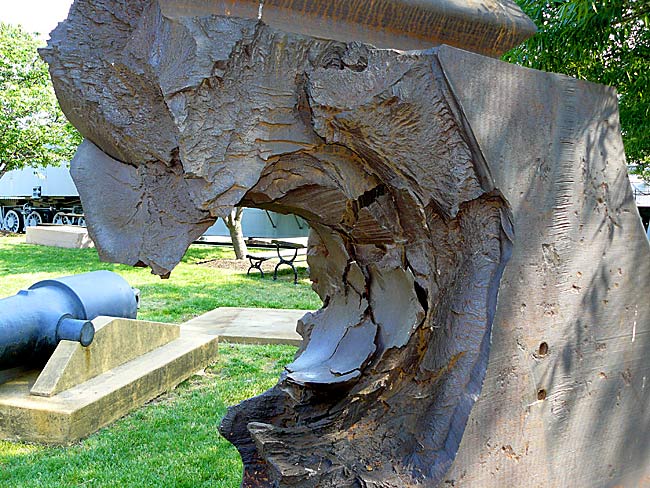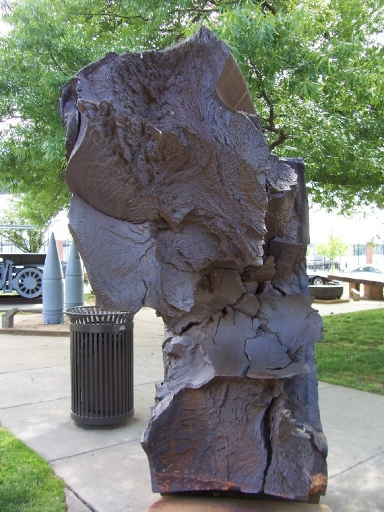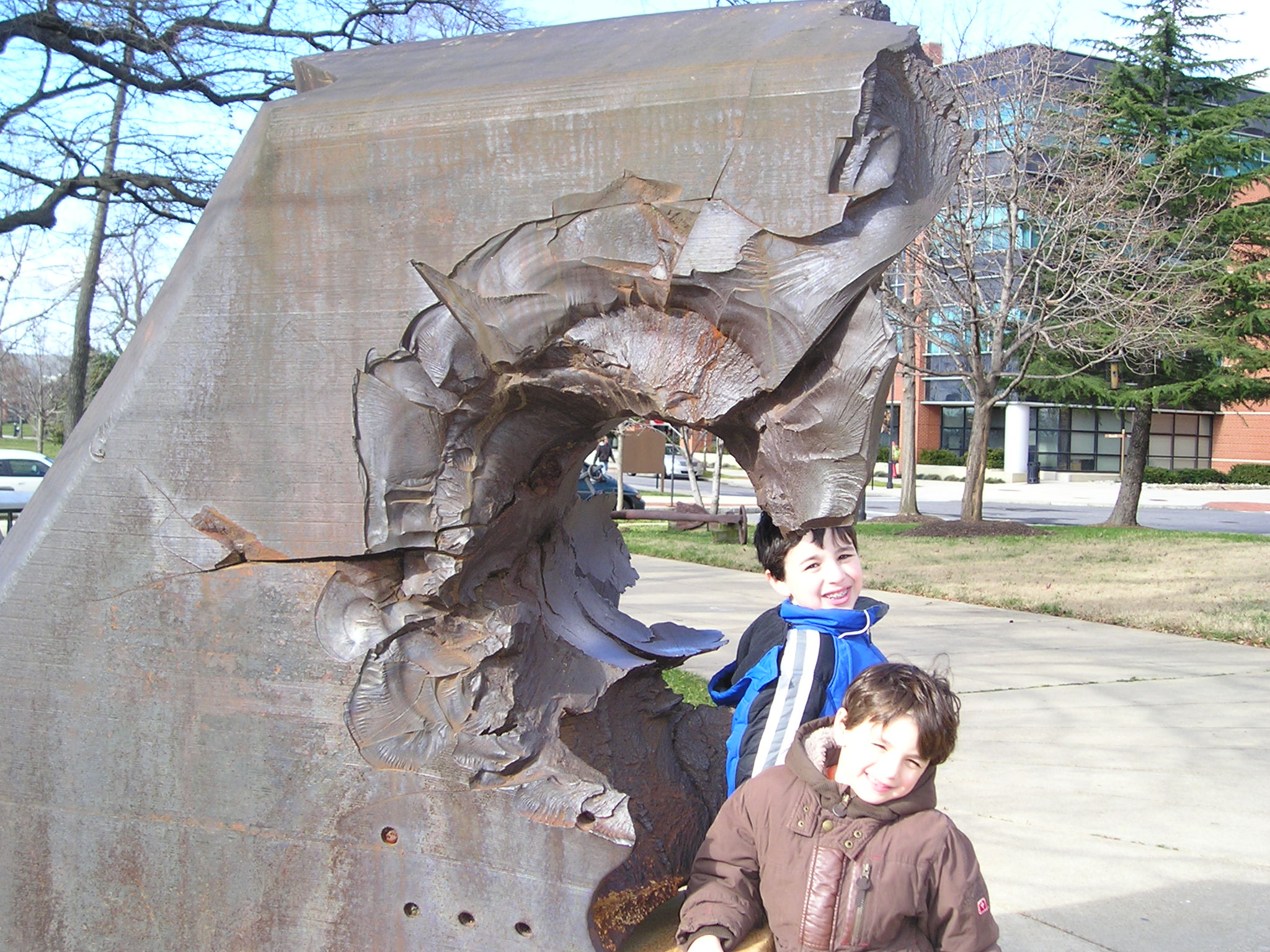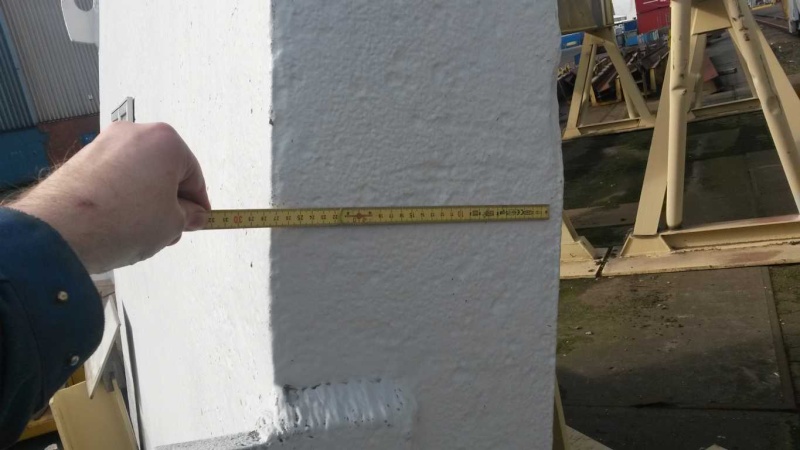
Esse É o efeito de um projetil de 16 polegadas sobre a blindagem de 26 polegadas de espessura dos encouraÇados japoneses da classe Yamato. A blindagem estÁ em exposiÇão no US Navy Museum

Esse É o efeito de um projetil de 16 polegadas sobre a blindagem de 26 polegadas de espessura dos encouraÇados japoneses da classe Yamato. A blindagem estÁ em exposiÇão no US Navy Museum
Replies sorted oldest to newest




O causador....

Que porrada! ![]()
caralh@#$%¨&*o ![]()
Uma desta deve doer ...
Rogerio77 posted:Uma desta deve doer ...
Que nada. Aposto que você não ia sentir rsrs
Eu conheço esse museu, fica em Washington, é um museu da marinha americana, que fica as margens do rio Potomac se eu não engano, esse peça fica exposta do lado de fora, é impressionante mesmo ver o tamanho do regaço que feito no casco de aço.
Uma curiosidade e pergunta de leigo:
A placa é referida como "... dos encouraçados japoneses da classe Yamato.".
Que eu saiba, da classe Yamato só houve dois, o próprio e o Musashi. Ambos afundados pela aviação ianque. Outro que estava em construção, e teria sido convertido para porta aviões, não foi terminado.
Aí a pergunta: como conseguiram essa chapa perfurada ?
Valls
Valls,
Foram projetados cinco Yamatos. O terceiro, convertido em porta-aviões e batizado de Shinano, foi concluído e afundado por submarino da US Navy em sua primeira viagem, quando era transferido de Yokosuka para Kure. O quarto, chamado de navio 111 e que nunca recebeu nome, foi cancelado quando estava 30% construído e desmanchado no estaleiro. O quinto foi cancelado antes de iniciada a construção. Imagino que a peça seja do 111.
Existe uma única foto decente do Shinano.

Os japoneses conseguiram manter em segredo a existência do Shinano. Foi tanto segredo que hoje só temos uma que preste, acima, tirada durante os seus testes de mar, em 11.11.1944 na baía de Tóquio. Nessa data ocorreram tb as únicas operações aéreas em seu convés de vôo, com pouso e decolagem de diversos tipos de aeronaves.
Quando Joseph Enright, comandante do submarino Archer-Fish, observou o navio pela primeira vez, pelo periscópio, não conseguiu identificar aquilo que estava vendo. No guia de reconhecimento da US Navy não havia nada parecido. Os mais próximos eram os porta-aviões Junyo e Hiyo, mas eles eram muito menores. De qualquer maneira, ele disparou uma salva de seis torpedos, dos quais quatro acertaram e despacharam o Shinano para o fundo do mar, em 29.11.1944, após uma lenta agonia.
Quanto o Archer-Fish retornou, ninguém acreditou no ocorrido. Chegaram a propor a Enright que desistisse de pedir crédito pelo afundamento do porta-aviões e aceitasse que havia afundado um cruzador. Ele insistiu e a realidade foi surgindo aos poucos.
Valls posted:Uma curiosidade e pergunta de leigo:
A placa é referida como "... dos encouraçados japoneses da classe Yamato.".
Que eu saiba, da classe Yamato só houve dois, o próprio e o Musashi. Ambos afundados pela aviação ianque. Outro que estava em construção, e teria sido convertido para porta aviões, não foi terminado.
Aí a pergunta: como conseguiram essa chapa perfurada ?
Valls
Essa chapa de blindagem foi encontrada pelos americanos no base naval de Kure, e então, levada para os EUA para teste. Era da blindagem frontal da torre de 460 mm do que seria o terceiro da classe do Yamato.
Aqui tem mais dados sobre os testes feitos com ela.
Interessante essa descrição dos testes. O último parágrafo é revelador.
Therefore, these plates are the only warship armor plates that could not be completely penetrated by ANY gun ever put on a warship when installed leaning back at 45°, as they were in the actual turrets!!! Even to completely hole the plate all the way through at that inclination requires a brand new 16"/50 Mark 7 or German 38cm SK C/34 gun at point-blank range firing the latest versions of their respective AP projectiles; it might be cracked at a lower striking velocity, but no hole put entirely through it! AND THEY SAID GUNS HAD COMPLETELY OVERMATCHED ALL ARMOR--*NOT SO*!!!
Segundo o texto, esses danos nas placas mostrados acima foram obtidos em condições distantes das reais e com as placas sem inclinação.
Paulors, olha que bacana essa discussão sobre uma situação onde um encouraçado da classe do Iowa seria atacado por mísseis anti navio.
http://warships1discussionboar...issiles#.VtN5QPkrKUk
A opinião desse usuário parece bem embasada:
"I have spoken to weapons annalists who work for NAVSEA and was surprised at the results of what they estimate would happen. In 1982 the threats she would have faced would be considerably different than today 27 years later. In the specific case of Exocet and Harpoon what Zen writes is true. No sub-sonic anti ship missile that has a blast fragmentation warhead can defeat the armored citadel. She has many redundant systems that can direct her main battery including 6 directors and now two CIC. One modern CIC and the older analog computers which are just as accurate. They can transmit shock damage through the armor but it would likely take many of these types of missles to even mission kill much less sink the ship.
The 500 lb charge that detonated on Cole's side would likely not even penetrate the 1.5" STS plating amidships and even if it did damage would be minimal.
Supersonic missles with shape charged warheads will penetrate the armored citadel. Some of these missiles are huge. These represent a major threat. Confined structures such as turrets and conning tower where the hot metal jet stream can bounce around the inside once the warhead detonates can knock them out. If a deck hit and this stream is pointed downward and it hits something like a magazine it could be very bad. However the ship is huge and the missine may not hit anything vital. It would still require multipe hits due to her size and subdivision to mission kill but with enough hits these missiles can sink her. If one hits a magazine it may destroy her just like a 16" shell that finds the magazine.
I was very suprised at Hypersonic missiles or missiles that travel at mach 6-7. These can penetrate any armor simply due to their size and the incredible velocity. These can even knock a turret off its foundation and remove large chunks of armor. Many of these weighed more than any projectile made. Due to the high speed the kinetic energy they will overwhelm any armor period. Here the ship must again depend on her size and subdivision to contain damage and due to her system redundancy unless the missile finds a magazine she would still require several hits.
Torpedoes that strike her side she has very good protection against and even if they do penetrate the side system just like in WWII it would take several to sink her. I was surprised to learn that her keel is not her strength deck. In fact she was designed that her armored deck is her strength deck. This deck is also supported by all the transverse bulkheads and side armor. The class B armor is ductile meaning it will elastically bend before it breaks. Breaking an Iowa's back by an under keel explosion would be extremely difficult. Shock damage could be severe but her hull structure would survive the 1,200 lb TNT equivalent charge of a single MK-48 torpedo. Locally it would defeat the triple keel and subdivision would contain flooding. Shock damage could be transmitted throughout the ship in a similar fashion as Tirpitz. I have asked about her rudder seals and the weapons annalists say her seals would hold even if the hit was directly below the shafts. Though this may jam one or both rudders and take out one or two shafts the flooding would likely be local and not go back to her engine rooms unless the shaft broke like in Prince of Wales. If it hit her bow forward of the armored citadel she would likely lose her bow. The estimate of 4-6 torpedoes to sink her is still a good estimate even if they are below the keel. However any submarine commander who gets within range to fire torpedoes should be court martialed if he only fires a single torpedo at a ship the size of an Iowa. USS America who's hanger deck is her main strength deck did quite well against torpedoes taking multiple hits during her sink-ex and she did not break in half.
The high altitude bunker buster bombs can also penetrate the deck armor but few HC bombs today can. The bunker busters are not designed to hit a moving target that can turn rapidly. This does not mean they can't but it would be more difficult.
My point is an Iowa can be overwhelmed just like Yamato was by multiple attacks. Overall most weapons that can be deployed would require multiple hits unless they strike a magazine. This is more a result of her size, subdivision, and system redundancy. She is not immune nor is a super carrier. She is more survivable once a hit has occurred than all surface combatants as the cruisers and destroyers can be cut in half by the same weapons. One problem I have is most people play a game of Iowa being alone. She has always operated within a task force even if she is hundreds of miles away from a carrier. The navy will command control of the air and control of the seas above and below because all their ships are vulnerable and they do not want any of their ships hit. Thus when looking at defensive measures you need to look at the navies capability on a whole and not Iowa alone. Once you do this any ship that can survive multiple hits complicates an opponents ability to attack due to the limited numbers of missiles that can be deployed against the task force.
Rob"
paulors posted:Interessante essa descrição dos testes. O último parágrafo é revelador.
Therefore, these plates are the only warship armor plates that could not be completely penetrated by ANY gun ever put on a warship when installed leaning back at 45°, as they were in the actual turrets!!! Even to completely hole the plate all the way through at that inclination requires a brand new 16"/50 Mark 7 or German 38cm SK C/34 gun at point-blank range firing the latest versions of their respective AP projectiles; it might be cracked at a lower striking velocity, but no hole put entirely through it! AND THEY SAID GUNS HAD COMPLETELY OVERMATCHED ALL ARMOR--*NOT SO*!!!
Se eu estiver correto, os 660 mm (26 polegadas) de blindagem, inclinado a 45º, equivaleriam a quase 800 mm!
Li que, nos Jagdtigers e Maus que foram fabricados, havia um procedimento de pinar as placas nas devidas posições antes de soldá-las, alem de outros dispositivos para move-las.
Daí, pensando nas dimensões ( e principalmente o peso) dessas, fico imaginando o que seria necessário em termos de recursos para manusear, montar e solda-las nas torres.
Valls
Outra pedaço de blindagem de um navio que foi afundado na WWII. Esta é a do Bismarck que se encontra no estaleiro da Blohm und Voss em Hamburgo.



Os blindados da Segunda Guerra tinham como blindagem o aço, atualmente, com materiais compostos, mantidos como segredo de cada fábrica de tanque, consegue-se mais resistência com espessuras menores de blindagem. Vocês que sacam de naval, os navios atuais contam com blindagens modernas, ou o advento de mísseis no lugar de canhões fez os fabricantes de navios militares abrirem mão da blindagem ? Não seria o caso de não fabricar navios com muita blindagem e forra-los com placas reativas, como se faz atualmente com os MBTs ?
Fernando,
Muito bom esse link que vc indicou. Já salvei para ler com calma.
http://warships1discussionboar...issiles#.VtN5QPkrKUk
Interessante a discussão sobre o possível efeito dos Exocet no Iowa. Uma coisa é acertar um míssil desses em um navio sem blindagem ou de alumínio, como nas Falklands. Agora, se o alvo for um couraçado da Segunda Guerra, com uma p... blindagem, a coisa fica complicada.
Rogério,
Até onde eu sei, com o advento das armas nucleares a blindagem deixou de ser um fator significativo. Acredito que os navios contem mais hoje com seus sistemas eletrônicos de vigilância e com um apoio aéreo que anule eventuais ameaças a uma distância segura.
O grande problema dos encouraçados era o tiro mergulhante. Pois se eu não me engano muitos tinham o convés de madeira.